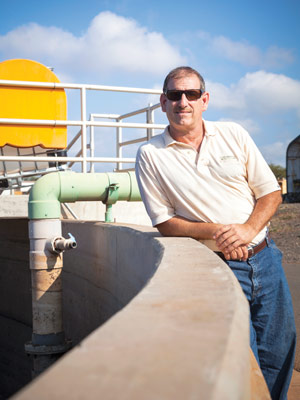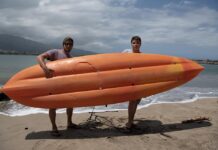 Steve Parabicoli
Steve Parabicoli
The Sweet Smell of Success
Say hello to Steve Parabicoli’s little friends.
Maui County’s water-recycling program coordinator geeks out over the beneficial bacteria he unleashes on sewage to start the process of turning it into usable water. Talking to kids about wastewater and asking them to peek inside a vial of microbial sludge is one of his favorite things to do.
“I love microbiology,” he grins. “When you look at that brown water under the microscope, it’s just teeming with life.”
For the past nineteen years, Parabicoli has been Maui’s effluent evangelist, bringing together private landowners, community members and county officials in the crusade to do more with the island’s cleaned-up wastewater than just throw it away.
In 2012, the program recycled 1.2 billion gallons, not only reducing the amount of treated sewage disposed of underground, where environmentalists fear it can seep out into nearshore waters, but saving the drought-prone island an estimated 600 million gallons of clean drinking water that would otherwise have been used for irrigation or landscaping.
Maui currently recycles an average 3.5 million gallons of water per day, around 31 percent of the wastewater that’s flushed down the drain. While that’s not the highest in the state, Maui’s still considered a leader in water recycling, because of legislation and sewer fees that promote reuse, and because of Parabicoli’s passionate pursuit of innovative uses for reclaimed water. Thanks to an ordinance by the Wastewater Reclamation Division, county code requires all commercial properties within 100 feet of recycled-water mains — public schools, county parks, private developments — to use that water for landscaping.
“We’re not just irrigating golf courses anymore.”
Under Parabicoli, the county added filling stations to its water-recycling facilities and hydrants to its reclaimed-water lines, so construction companies could fill their tanker trucks with water for dust control and cement mixing. Reclaimed water is starting to be used by more and more agricultural customers. That’s an area where Parabicoli expects to see a big expansion.
“Our Kihei and Lahaina facilities produce R1 recycled water, the highest level classified by the state Department of Health,” he says. “It’s not used for human consumption here, but it could be, with additional treatment. Many of the vegetables we buy are irrigated with recycled water, and R1 is approved as drinking water for livestock.” For farmers and ranchers looking for a dependable water source, “we can offer that with recycled water. It’s drought-proof.”
The infrastructure for reclaimed water is separate from the one that runs to your tap, and costs many millions to install. Currently, the county has the infrastructure to distribute recycled water only in Kihei, which reuses an average of 50 percent of its water, and Lahaina, which reuses about 38 percent.
But those numbers will increase soon. A planned expansion of the Lahaina system will immediately add 300,000 to 400,000 gallons per day, and attract a roster of new customers in West Maui. A Kihei expansion will add another 250,000 gallons per day.
“One thing we’ve learned,” Steve says, “if you build it, they will come.”
— Ilima Loomis





